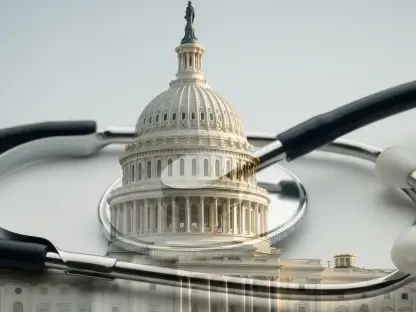Introduction to Trump’s Tariff Policies
The landscape of American trade policy has been dramatically reshaped by President Donald Trump’s aggressive tariff measures, implemented earlier this year, which have sparked intense legal and economic debates across the nation, affecting businesses, consumers, and policymakers alike. These tariffs, enacted under the International Emergency Economic Powers Act (IEEPA) to address a declared national emergency over the U.S. trade deficit, represent a bold attempt to protect domestic industries. With an average rate of 18.6%, the highest since the 1930s, they cover roughly two-thirds of U.S. imports, impacting everyday essentials like smartphones, clothing, and automobiles. This sweeping policy has not only altered market dynamics but also set the stage for a historic confrontation in the Supreme Court, drawing widespread attention.
The scale of these tariffs has reverberated through various sectors, affecting supply chains and pricing structures for countless goods. Businesses face increased costs for imported materials, while consumers grapple with higher retail prices on a vast array of products. Policymakers, meanwhile, are caught in a tug-of-war over the balance of executive power and legislative authority, questioning the long-term implications of such unilateral trade actions. As tensions mount, the legal and economic battles surrounding these policies have become a focal point, with profound consequences hanging in the balance.
This contentious environment underscores the urgency of understanding the broader impact of Trump’s trade strategy. Stakeholders across the spectrum are bracing for potential shifts in policy direction, depending on judicial outcomes and political responses. The intersection of law, economics, and governance has rarely been so pronounced, making this a critical moment for assessing how these tariffs will shape the future of American commerce and international relations.
Legal Challenges and Supreme Court Involvement
Federal Appeals Court Ruling and Legal Basis
The legal foundation of Trump’s tariffs faced a significant setback when the U.S. Court of Appeals for the Federal Circuit delivered a 7-4 ruling on August 29, declaring most of these tariffs illegal. The court’s decision hinged on the constitutional principle that tariff authority is reserved for Congress, not the executive branch, challenging the use of IEEPA as justification for such broad measures. This landmark ruling emphasized the necessity for explicit procedural and substantive limits on presidential tariff powers, a standard the court found lacking in the current policy framework.
Prior findings from the U.S. Court of International Trade had already cast doubt on the legality of these emergency declarations, reinforcing the appeals court’s stance. The judicial critique centered on the absence of clear congressional delegation, arguing that unchecked executive action in this realm undermines the separation of powers enshrined in the Constitution. Such legal reasoning has intensified the debate over how much latitude a president should have in enacting trade policies under emergency pretexts.
This pivotal decision has propelled the issue to the Supreme Court, marking a critical escalation in the battle over tariff legitimacy. The ruling has not only questioned the current administration’s approach but also sparked a broader discourse on the boundaries of executive authority in economic matters. As the nation awaits a higher court’s verdict, the implications for governance and trade regulation remain a pressing concern for all involved parties.
Supreme Court Review and Potential Outcomes
The Supreme Court has taken up the tariff issue on an expedited basis, with oral arguments conducted on November 5, reflecting the urgency of resolving this high-stakes dispute. During these sessions, several justices expressed skepticism toward the notion of unchecked presidential power to impose tariffs under emergency declarations, hinting at potential limits to executive discretion. This judicial scrutiny underscores the gravity of the case, as it could redefine the scope of authority under IEEPA.
A ruling from the Supreme Court could have far-reaching consequences, determining not only the legality of the existing tariffs but also setting a precedent for future presidential actions in trade policy. If the court upholds the appeals ruling, it may invalidate a significant portion of the tariffs, forcing a reevaluation of current trade strategies. Conversely, a decision favoring the administration could cement broader executive powers, altering the balance between legislative and presidential roles in economic governance.
The uncertainty surrounding the final verdict keeps markets and policymakers on edge, as the outcome will likely influence international trade agreements and domestic economic planning. Beyond immediate tariff implications, the decision promises to shape legal interpretations of emergency powers for years to come. This case stands as a defining moment, with the potential to recalibrate the framework of American trade policy and governmental checks and balances.
Economic Impact of Tariffs on Consumers and Markets
The economic ramifications of Trump’s tariffs have been immediate and substantial, placing a noticeable burden on U.S. households and businesses. According to Yale’s Budget Lab, the average American family now pays an additional $2,400 annually due to these tariffs, translating to a 1.8% increase in overall costs. This financial strain affects a wide range of goods, from basic necessities to larger purchases, reshaping consumer spending patterns across the board.
Specific price increases have hit hard, with shoes seeing a nearly 40% hike, apparel rising by 37%, and car prices jumping by thousands of dollars. These surges contribute to inflationary pressures, complicating efforts to stabilize the economy amid already volatile conditions. The ripple effects extend beyond individual budgets, as businesses struggle with higher input costs, often passing these expenses on to consumers or scaling back operations.
Looking ahead, economic experts warn of even graver long-term consequences, projecting a potential 6% reduction in GDP and a 5% decline in wages if the tariffs persist. Such forecasts highlight the risk of sustained damage to economic growth and living standards, creating uncertainty for industries reliant on imported goods. The mounting costs and unpredictability underscore the urgent need for clarity on the tariffs’ future, as markets and households navigate this challenging terrain.
Political Divisions and Policy Debates
The tariff policies have ignited sharp political divisions, with President Trump staunchly defending them as vital for safeguarding American jobs and industries. Through platforms like Truth Social, Trump has argued that reversing the tariffs would spell economic disaster, framing them as a cornerstone of national prosperity. His administration contends that these measures are essential to countering unfair trade practices and bolstering domestic manufacturing.
In stark contrast, critics such as Senator Amy Klobuchar (D-Minn.) have decried the tariffs as a regressive burden on American consumers, driving up costs for everyday goods. Klobuchar advocates for policies focused on reducing expenses rather than imposing what she terms “tariff taxes,” reflecting a broader push for consumer relief. This perspective resonates with many who see the tariffs as counterproductive to economic well-being, fueling a contentious policy debate.
Amid this polarization, bipartisan efforts have emerged to address the issue of executive overreach, exemplified by the proposed Trade Review Act of this year, spearheaded by Senators Klobuchar, Maria Cantwell (D-Wash.), and Chuck Grassley (R-Iowa). This legislation aims to strengthen congressional oversight over tariff impositions, signaling a shared concern about unchecked presidential authority. The interplay of staunch defense and critical opposition continues to shape the political landscape, with significant implications for future trade governance.
Future Implications for Trade and Presidential Power
The Supreme Court’s forthcoming decision on the tariffs holds profound implications for the trajectory of U.S. trade policy and the delineation of presidential power. A ruling against the tariffs could necessitate a rapid unwinding of current measures, potentially disrupting established trade agreements and affecting American competitiveness, as cautioned by the Trump administration. Such an outcome would likely prompt a reevaluation of how trade emergencies are declared and managed.
Conversely, plaintiffs like the Pacific Legal Foundation argue that upholding the tariffs without constitutional backing risks eroding the checks and balances fundamental to governance. A decision favoring strict limits on executive authority could embolden legislative efforts to impose clearer constraints, reshaping the framework for emergency economic actions. This legal crossroads will undoubtedly influence how future administrations approach trade disputes and national emergencies.
Emerging trends in trade policy also point to a growing consumer burden and a legislative push for greater oversight, which could redefine economic strategies in the coming years. The balance between protecting domestic interests and maintaining affordable access to goods remains a delicate challenge. As these dynamics unfold, the intersection of judicial rulings and policy reforms will play a critical role in determining the sustainability and direction of U.S. trade practices.
Conclusion and Outlook for 2025 and Beyond
Reflecting on the intense debates and analyses surrounding Trump’s tariff policies, it becomes evident that the Supreme Court’s role is central in navigating the legal, economic, and political complexities of this issue. The clash over executive authority versus congressional power unfolds as a defining struggle, with tangible impacts felt by households through rising costs. Economic projections paint a sobering picture of potential long-term damage, while political divisions highlight the deep-seated challenges in crafting cohesive trade strategies.
Moving forward, stakeholders need to prioritize collaborative solutions, such as advancing legislative frameworks like the Trade Review Act to ensure balanced oversight. Businesses and policymakers must prepare adaptive strategies to mitigate disruptions, whether through diversifying supply chains or advocating for targeted exemptions. For consumers, advocacy for cost-relief measures emerges as a critical next step to alleviate the financial pressures that have mounted.
Ultimately, the resolution of this tariff showdown promises to set a lasting precedent, and it is imperative for all parties to engage in proactive dialogue to shape a trade environment that supports both economic stability and constitutional integrity. The path ahead demands vigilance and innovation to address the evolving challenges, ensuring that American trade policy adapts effectively to global and domestic needs in the years that follow.









